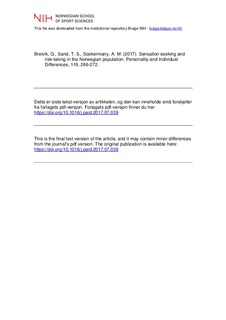| dc.contributor.author | Breivik, Gunnar | |
| dc.contributor.author | Sand, Trond Svela | |
| dc.contributor.author | Sookermany, Anders McDonald | |
| dc.date.accessioned | 2020-02-05T11:41:32Z | |
| dc.date.available | 2020-02-05T11:41:32Z | |
| dc.date.created | 2017-09-19T00:45:58Z | |
| dc.date.issued | 2017 | |
| dc.identifier.citation | Personality and Individual Differences. 2017, 119, 266-272. | nb_NO |
| dc.identifier.issn | 0191-8869 | |
| dc.identifier.uri | http://hdl.handle.net/11250/2639788 | |
| dc.description | I Brage finner du siste tekst-versjon av artikkelen, og den kan inneholde ubetydelige forskjeller fra forlagets pdf-versjon. Forlagets pdf-versjon finner du på sciencedirect.com / In Brage you'll find the final text version of the article, and it may contain insignificant differences from the journal's pdf version. The definitive version is available at sciencedirect.com | nb_NO |
| dc.description.abstract | The article is based on a comprehensive study of the relation between sensation seeking and various forms of risk-taking in a representative sample of the adult Norwegian population, aged 15 years and above (N = 1000). The study included social, intellectual, financial, achievement-related, political, physical, ethical and existential risktaking dimensions. There was an expected main effect for age as well as gender on total sensation seeking, but no main effect for social class. All sensation seeking scales correlated positively with all the risk dimensions, although moderately for most scales. Physical risk had the highest correlation scores. The study found that altogether 21, 2% of the general population had been involved in risky activities during their life and had elevated scores on sensation seeking. A relatively high percentage of the population would be willing to be involved in risky sports (35,7%), risky jobs (54,8%) or risky military operations (25,9%), provided they were in good shape and of the right age. Those who were willing had higher sensation seeking scores. Only 16,9% of the population thought basejumping or other risk sports should be prohibited. The prohibitionists had lower sensation seeking scores than the non-prohibitionists. | nb_NO |
| dc.language.iso | eng | nb_NO |
| dc.relation.uri | http://www.sciencedirect.com/science/article/pii/S0191886917304889 | |
| dc.subject | sensation seeking | nb_NO |
| dc.subject | risk-taking | nb_NO |
| dc.subject | risk sports | nb_NO |
| dc.subject | risky jobs | nb_NO |
| dc.subject | military operations | nb_NO |
| dc.title | Sensation seeking and risk-taking in the Norwegian population | nb_NO |
| dc.title.alternative | Sensation seeking and risk-taking in the Norwegian population | nb_NO |
| dc.type | Journal article | nb_NO |
| dc.type | Peer reviewed | nb_NO |
| dc.description.version | acceptedVersion | nb_NO |
| dc.subject.nsi | VDP::Idrettspedagogikk og -psykologi: 333 | nb_NO |
| dc.subject.nsi | VDP::Physical education and sport psychology: 333 | nb_NO |
| dc.source.pagenumber | 266-272 | nb_NO |
| dc.source.volume | 119 | nb_NO |
| dc.source.journal | Personality and Individual Differences | nb_NO |
| dc.identifier.doi | 10.1016/j.paid.2017.07.039 | |
| dc.identifier.cristin | 1495108 | |
| dc.description.localcode | Seksjon for kultur og samfunn / Department of Cultural and Social Studies | nb_NO |
| cristin.unitcode | 150,33,0,0 | |
| cristin.unitname | Seksjon for kultur og samfunn | |
| cristin.ispublished | true | |
| cristin.fulltext | postprint | |
| cristin.qualitycode | 1 | |
